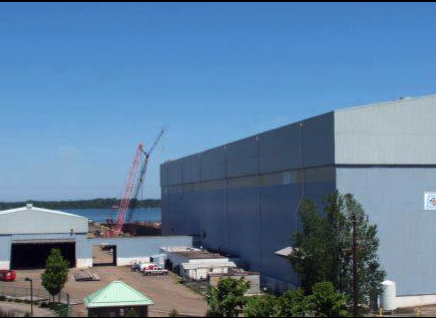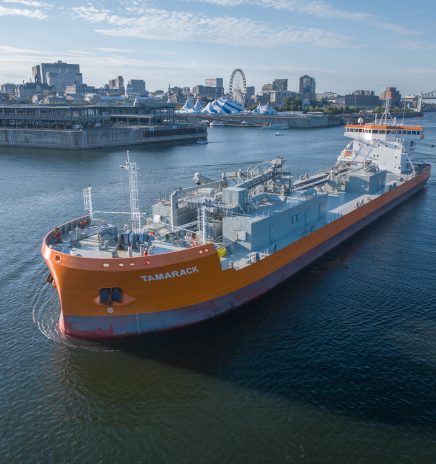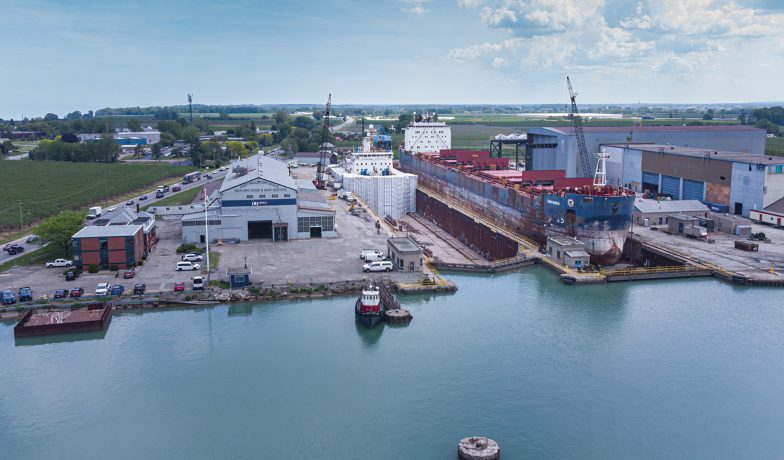Anticipating a Bright Future
Ontario Shipyards reflects on new name and expanding vision
On January 1, 2024, Heddle Shipyards, headquartered in Hamilton, Ontario, changed its name to become Ontario Shipyards. Heddle was founded singularly by Rick Heddle, a welder, in 1987. For 37 years it has prospered to become the largest Canadian ship repair and construction company on the Great Lakes. In addition to its Hamilton Shipyard, Ontario operates the Port Weller Dry Docks in St. Catharines and the Thunder Bay Shipyard in Thunder Bay. Now, all the company’s operating entities are consolidated under the Ontario Shipyards brand.

At the time of the announcement, president and CEO Shaun Padulo said “the rebranding of our company to Ontario Shipyards marks a significant shift. It is a poignant signal that our company will activate and harness the capacity, capabilities and output of Canada’s industrial heartland to build and fix ships. We will always maintain the core values that have made us successful.” The company’s slogan is: “Ontario Shipyards is Where Water Meets Mettle™.”
Ted Kirkpatrick, director of business development and government relations for Ontario Shipyards, said the name change signals a wave of new directions and new activities.
Kirkpatrick noted that the province of Ontario was once the epicenter of shipbuilding in Canada, with more than 80 commercial and government vessels built at the Port Weller Dry Docks and many more at historic Thunder Bay. For the industry, that level of activity slowed in the mid-1990s to around 2010. Then, in 2012, the Government of Canada introduced its National Shipbuilding Strategy, an effort to revitalize Canadian shipyards and support Navy and Coast Guard vessel construction in Canada, goals that obviously require strong domestic shipyards.
Expanding Capabilities
Ontario Shipyards wants its new name to show a parallel alignment with Canada’s national shipbuilding activities. The old name connotes a more restricted operational context. “We want our name and brand to reflect all of the large shipyard assets in Ontario,” Kirkpatrick explained. Additionally, the change is a deliberate reference at industrial capabilities beyond the shipyards themselves, particularly resources and talents in steel production, advanced manufacturing, logistics and skilled workforce. Ontario Shipyard draws on those capabilities for its work, Kirkpatrick said, and the company wants its new name to reflect that it is well positioned within an extensive and rich industrial context. “We think our new name will help us leverage our position to support all of the economic activities necessary for shipbuilding,” he explained.
He cited an example of such leveraging: the steel for a recent ferry project was sourced from a nearby vendor, sent to Ontario ready for welding. The ability to access high-quality materials from expert companies in such production is an advantage, Kirkpatrick said. It’s a dependable logistics chain that allows the shipyard to focus on its core activities and remain nimble and flexible regarding material and inventory. A varied supply chain also provides redundancy: if one company can’t meet a deadline it’s highly likely that another source can deliver. He said some shipbuilders have all related activities in-house. “That’s not our model,” he explained, “because regionally we have so many companies that can provide those products and services. They do well. It’s cost effective for us.” This local and regional interaction makes the economic pie bigger, so to speak. Again, a reason for the name change – to reflect an expansive impact beyond the singular shipyard.
With these efforts, Kirkpatrick said new capital investments are on the horizon. One specific interest is in robotic welding and related equipment. Ontario has three core business areas:
- Marine construction: work includes a variety of projects in Hamilton, from workboats to barges, cable ferries and sub-sea cable-laying equipment.
- Vessel maintenance and overhauls: including standard and emergency repairs and maintenance and conversions. Other projects include steel replacement, re-powering and structural remodeling.
- Vessel recycling.
Ontario Shipyards also supports a wide range of civil maritime infrastructure and construction. Project support services include terminal operations, the chartering and or sale and purchase of assets, support of marine operations, (i.e. outfitting and reinstatement of equipment) and leasing portions of the company’s facilities. In the Great Lakes region, Ontario has provided project support for the subsea cable industry as well as fabrication, fit-out and reinstatement support for marine infrastructure projects.
Government Support
Kirkpatrick noted that his company and the province’s maritime sector are fortunate because the Ontario government already supports regional shipyard activities and ship building.
This support includes C$3.7 million in funds in 2023, granted through Canada’s Skills Development Fund. The money is to help train 300 shipyard workers, apprentices and jobseekers in Hamilton and Port Weller. Plus, in May 2022 the province invested C$8.7 million in Ontario Shipyards (then still Heddle) to launch the Ontario Shipyard Modernization Project, part of a broader, cooperative project in which Ontario Shipyards was to develop a standardized curriculum for a Ship Repair and Shipbuilding Pilot Course with Mohawk College, Niagara College and Confederation College.
Kirkpatrick said these workforce efforts have been valuable. “Labor and skilled trades,” he commented, “are the challenges everywhere, in Canada and the US.” He said recent workforce grants allowed his company to purchase new equipment and then train operators.
Kirkpatrick also expressed Ontario Shipyards’ support for the province’s newly developed “Marine Transportation Strategy.” “What’s really important about the strategy is that Ontario recognized that shipbuilding is not only an important part of the regional economy but that (officials) need to develop policies that will grow and support the industry,” he said.
Kirkpatrick added that Ontario can become more competitive against other provinces that already have a specific maritime transport focus. He hopes one 2024 priority for Transport Ministry officials is developing the financial incentives referenced within the strategy. Again, he sees this as a competitive issue because shipyards in other provinces already benefit from various government funding programs. “They have a leg up on us before we even put pen to paper. We’d like to see what financial mechanisms will develop to help level the playing field.”
Another good upcoming move, Kirkpatrick said, is the strategy’s proposal to establish a new “Ontario Marine Partnership and Development Office.” Shipbuilding contracts, he said, “can cross multiple ministries.” A central contact point will be helpful for a company that must maneuver through various agencies.
Overall, Kirkpatrick is confident the shipbuilding sector in Ontario has a bright future. “There’s a tremendous amount of opportunity out there under the National Shipbuilding Strategy,” he said. “They need a large number of vessels, and they will get built.”

Donjon Marine Acquired by Investment Firm Tallvine
Donjon Marine Co. LLC, which operates a shipyard in the Great Lakes, has been acquired by Miami-based investment firm Tallvine Partners. Donjon Marine was founded in 1964 and operates dredging,... Read More

M/V Tamarack is First Newbuild Cement Ship in the Great Lakes in 20 Years
M/V Tamarack arrived at the Port of Montreal on August 22, completing her maiden transatlantic voyage and marking a major milestone in North American shipping. Owned by Eureka Shipping, a joint... Read More



